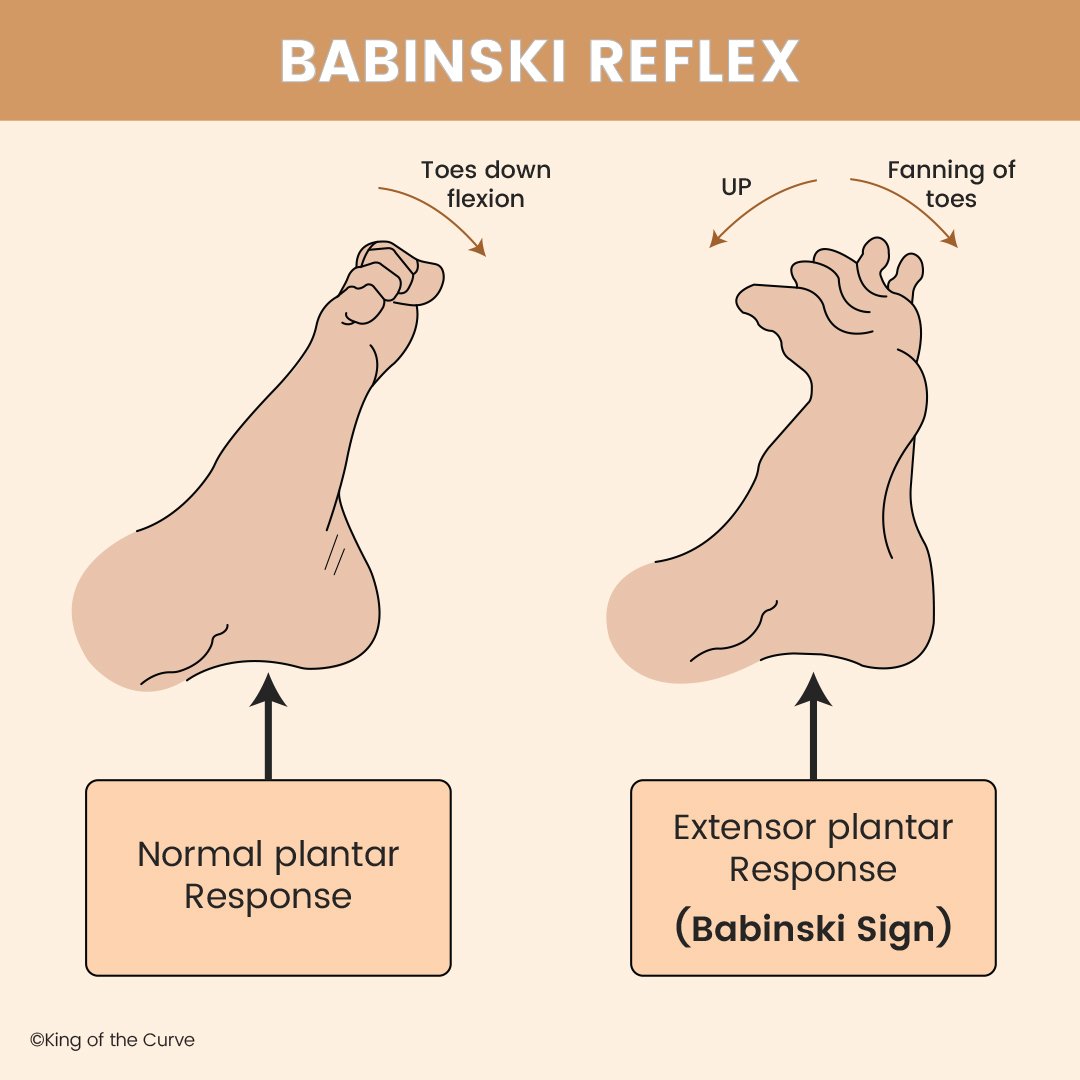Understanding the Babinski Reflex: A Key Neurological Indicator
The Babinski Reflex is a hallmark neurological test that plays a pivotal role in assessing the integrity of the central nervous system. Whether you’re a medical student preparing for the NCLEX or MCAT, a nursing student, or in any health-allied field, mastering this concept is crucial. This post will simplify the Babinski Reflex and help you understand its clinical relevance, using resources and learning strategies provided by King of the Curve (KOTC).
What is the Babinski Reflex?
The Babinski Reflex, also called the Plantar Reflex, is a physical test used to evaluate the functioning of the corticospinal tract—a key component of the central nervous system.
Normal Response (Downward Plantar Reflex): Stroking the sole of the foot leads to downward flexion of the toes.
Positive Babinski Sign (Extensor Plantar Reflex): Stroking the sole causes dorsiflexion of the big toe and fanning of the other toes.
This reflex is normal in infants (up to 1 year old) because their corticospinal tract is not fully myelinated. However, in adults, a positive Babinski sign often indicates a neurological disorder.
When is the Babinski Reflex Tested?
The Babinski Reflex is tested during a neurological exam to detect possible damage to the:
Brain: Lesions or trauma affecting motor pathways.
Spinal Cord: Diseases like multiple sclerosis or trauma to the corticospinal tract.
Peripheral Nervous System: Conditions like amyotrophic lateral sclerosis (ALS).
How to Perform the Babinski Test
Position the Patient: Ensure the patient is lying down with their feet exposed.
Stimulate the Sole: Use a blunt instrument to stroke the sole of the foot firmly, starting at the heel and moving upward toward the toes along the lateral edge.
Observe the Response:
Normal: Toes curl downward.
Positive Babinski Sign: Big toe dorsiflexes (points upward) and smaller toes fan out.
Clinical Significance of the Babinski Reflex
1. Normal vs. Abnormal Reflex
Normal Reflex: Indicates healthy corticospinal pathways in adults.
Abnormal Reflex: A positive Babinski sign in adults often suggests neurological conditions, such as:
Stroke
Traumatic brain injury
Multiple sclerosis
ALS
2. Infants and the Babinski Reflex
Why Positive in Infants? Infants have an underdeveloped corticospinal tract, so a positive Babinski sign is expected.
When Does It Disappear? The reflex typically disappears after 1 year, as the nervous system matures.
Tips for Remembering the Babinski Reflex
Mnemonic for Adults vs. Infants:
"Up for infants, Down for adults."
This helps you recall that dorsiflexion (positive sign) is normal for infants but abnormal for adults.
Visual Learning:
Use diagrams like the one provided by KOTC to reinforce the difference between normal and positive reflex responses.
Quiz Yourself:
Test your understanding with adaptive questions on platforms like KOTC.
Connect Clinical Scenarios:
Relate the reflex to diseases like ALS or multiple sclerosis for better retention.
The KOTC Approach: Making Learning Effortless
At KOTC, we believe in learning that lasts. With over 100,000 downloads and recognition in Forbes 30 Under 30, our platform supports students from all backgrounds in achieving their dreams.
Our Values
Effortless and Rewarding Results: Simplify complex medical topics through engaging tools.
Diversity and Accessibility: With 35% of our users from underrepresented backgrounds, we’re committed to making education inclusive.
Long-Term Success: Build a foundation for your career with concepts that stick.
Conclusion
The Babinski Reflex is a fundamental part of neurological exams, and understanding it is essential for future healthcare professionals. By integrating resources from King of the Curve, you can confidently tackle concepts like this and excel in your studies.
Take the stress out of exam prep and let KOTC guide your journey to success!
Frequently Asked Questions (FAQs)
-
A positive Babinski sign in adults is often indicative of corticospinal tract damage, seen in conditions like stroke, spinal cord injury, or multiple sclerosis.
-
In infants, the corticospinal tract is not fully developed, so a positive Babinski sign is expected and normal.
-
The sole of the foot is stimulated with a blunt object, and the toes' movement is observed to determine the reflex response.
-
Yes, it can reappear in adults due to neurological damage after being absent in childhood.
-
The Babinski Reflex specifically evaluates the corticospinal tract, whereas other reflexes like the knee-jerk test assess different parts of the nervous system.
-
KOTC provides adaptive learning tools, visual aids, and gamified features to simplify complex topics like the Babinski Reflex.


